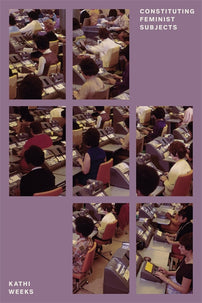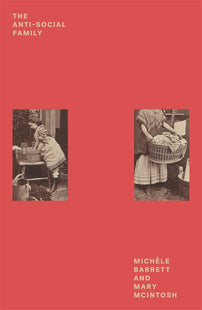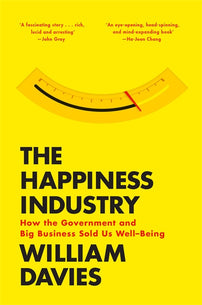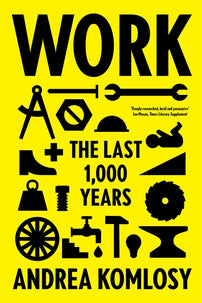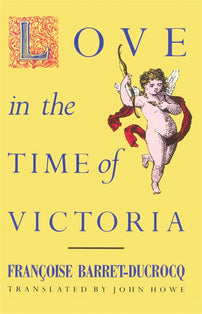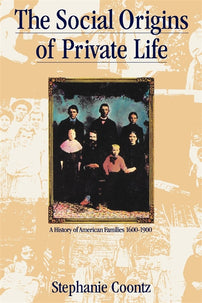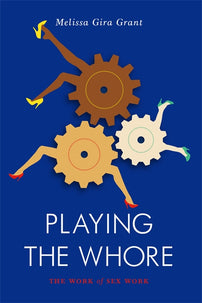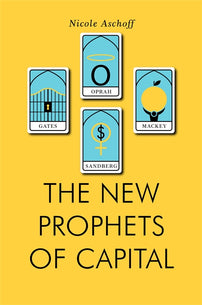Down with Love: Feminist Critique and the New Ideologies of Work
Kathi Weeks draws on 1970s feminist critiques of romance to investigate the contemporary management discourses of love and happiness at work.

First published in WSQ: Precarious Work. On Wednesday, February 14 in New York, Kathi Weeks and other contributors to the issue will appear at the Martin E. Segal Theatre at the CUNY Graduate Center for Slam Precarious Work, an issue launch party.
Love and work were once thought to operate in separate gendered spheres. The private realm of the family was where we fell in love and lived happily ever after; when we crossed into the public world of waged work, we entered into economic contracts to exchange labor for income. Or at least that was the story. In the 1970s, radical and Marxist feminists mounted a forceful challenge to this institutional model and social imaginary. By revealing the private household as an obscured component of the economy, as the primary locus of the reproductive labor necessary to productive labor and a mechanism by which wages are distributed to some of those marginal to or cast aside by the labor market, feminist theorists demonstrated how the spheres of work and family were continuous rather than autonomous. Marxist critiques of waged labor were thereby retrofitted so that they could be applied to domestic work and the familial relations of reproduction. For example, using the waged work economy as a lens through which to rethink the institution of the family, the proponents of the 1970s demand for wages for housework named much of what happens in the household “work” as a way to make domestic labor at once visible as productive effort (saying it deserved a wage was one way to do this) and, at the same time, to insist that it is not something to celebrate or revere (after all, it is only work). By these and other means, 1970s feminists succeeded brilliantly in shining critical light on the heretofore hidden abodes of the family, marriage, heterosexual love, and romance, and confronting the various modes of ideological mystification, naturalization, privatization, and romanticization that had shielded these institutions from critical judgment.
While there is still much we can learn from applications of this early iteration of the Marxist-feminist analytic which, by showing the family as connected to rather than the antithesis of work, deployed a version of the separate spheres model in order to disrupt it, we live today in new times that require additional critical methodologies. These new times can be narrated perhaps most succinctly in terms of the passage from a Fordist to a post-Fordist regime of accumulation. One of the remarkable features of the contemporary post-Fordist economy is how traditional forms of women’s work have come to characterize so many different kinds of employment. As many feminist political economists have by now recognized, "the conditions elaborated by feminists to surround women’s labour have now become generalized conditions of work" (Adkins and Jokinen 2008, 142). Consider, for example, how the modes of mental and manual labor once disaggregated across many industrial jobs are now often integrated, together with labors of the heart and soul, in postindustrial production. To the extent that the flexible, caring, emotional, cooperative, and communicative model of femininity has come to represent the ideal worker, women’s work under Fordism has arguably become the template for, rather than merely ancillary to, post-Fordist capitalist economies.
One consequence of these developments is that more and more of workers’ subjectivities become folded into and fused with their identity as workers. To configure work as the center of our identity requires a reconfiguration of the self in its relationship to work. This is facilitated by the fact that, mimicking the unbounded qualities of household care work, in the contemporary economy the borders that were once thought to separate waged work from nonwork time, spaces, practices, and relations are widely acknowledged to have broken down. Waged work and its values have thus come to dominate ever more of our time and energy. “On average, we only have 27,350 days on this planet,” declares one self-help manual for how to succeed at work, “and 10,575 of those are working days” (Baréz-Brown 2014, 12). Hence, we need to recalibrate ourselves individually to the fact that “life and work are intrinsically linked. They are not separate; they are one” (10). The spheres of life that were once imagined as separated into heartless world and loving haven are becoming increasingly confounded in this topsy-turvy period, with intriguing and sometimes disturbing results. Whereas in the late 1990s Arlie Hochschild observed a trend in the emotional reversal of our commitments to work and family, so that many were finding work more homelike and family more work-like (1997), more recently, Melissa Gregg in her book Work’s Intimacy (2011) writes about the more intimate relationship that many workers have to work and the romance narratives used to characterize their love for and happiness with it.
It is this last trend that will be the focus of my discussion because today management discourse seems to be obsessed with love and happiness. Popular management and career consultants tell us that love and happiness at work are good for both employers and employees, and the only thing the employee needs in order to accomplish this affective rewiring and emotional disciplining — and employees, they endlessly repeat, are the only ones who can do it — is “wide-eyed enthusiasm” (Kjerulf 2014, 172). Do what you love, they preach; learn how to love your work in ten easy steps. Fall back in love with your job. Learn even to love the work you hate. The future of work is happy. An often-cited quotation from one of the inspirational figures of this trend, Steve Jobs, distills many of the key themes of this literature:
Your work is going to fill a large part of your life, and the only way to be truly satisfied is to do what you believe is great work. And the only way to do great work is to love what you do. If you haven’t found it yet, keep looking. Don’t settle. As with all matters of the heart, you’ll know when you find it. And, like any great relationship, it just gets better and better as the years roll on. So keep looking until you find it. Don’t settle. (2005)
As Miya Tokumitsu observes, “happiness, love, passion, and self-fulfillment are today’s work virtues” (2015, 11).
Whereas an earlier version of what Phyllis Moen and Patricia Roehling name the “career mystique” — which idealized the iconic Fordist employment contract — depended on the hidden material support and ideological cover of the “feminine mystique” of domesticity that Betty Friedan so effectively exposed (Moen and Roehling 2004), a new career mystique, a version that extols the emotional commitment and entrepreneurial zeal of the ideal post-Fordist wage worker, is banking on another familiar feminine mystique, one that celebrates the happy raptures of romantic love as the essence of feminine fulfillment. The old cliché “that women live for love and men for work” that Shulamith Firestone struggled against in her masterwork, The Dialectic of Sex (1970, 113), must now be adjusted to a rather unexpected update: we should all love our work. In this way, under heteropatriarchal capitalism, the ideology of romantic love born of the separate spheres, an idealized and feminized model of love, is being harnessed, not only to continue to assign domestic work to women, but to recruit all waged workers into a more intimate relationship with waged work.
Just as the Protestant work ethic can be construed as an ideology propagated by the bourgeoisie and inculcated into the working classes, the current discourse of love and happiness at work undoubtedly finds its greatest resonance within the professional and managerial classes. But just as the work ethic in the U.S. today circulates widely in the culture — as well as among employers, public officials, and policymakers — as an unquestioned value, the mandate to love our work and be happy with it is arguably becoming increasingly hegemonic as a cultural script and normative ideal. The improbability of its claims about how workers can find meaningful delight in their jobs, its seeming irrelevance to the real conditions of most employment, has not prevented the ideals of love and happiness in and through work from coming to set a broader cultural standard, one that affects a growing swathe of workers. To be competitive in this job market and to hold on to, let alone advance within, whatever job we might manage to land, we will need to adapt, in some way and to some degree, to the workplace-feeling rules and affective expectations that are increasingly being imposed up and down the labor hierarchy. Whether that means an employee will be required to employ the transformative effects of deep acting to satisfy an employer’s expectation of happy workers, or only to display the approved countenance by means of surface acting, depends on the employee’s location in the waged labor force. 1 But given the shift in the balance of power between labor and capital under neoliberal restructuring, which bestows on employers the luxury of “playing the field,” more and more prospective employees mindful of their ongoing employability will need to work continually on their lovingness and aptitude for happiness at work.
To confront this new frontier in the transformation of work and its ideological supports, I want to approach the contemporary economy from another angle. Rather than building on a model that 1970s feminists pioneered and using the model of waged work to investigate the gender division of labor in the privatized household, in the analysis that follows I borrow from feminist analyses of the so-called private sphere to better understand our attachments to work and to the identities we invent and invest there. For my specific purpose here, I will isolate a very particular point of focus from that richly wide-ranging set of investigations into what had been deemed personal terrain. I want to draw on feminist critiques of the happily-ever-after narratives of heterosexual love and romance to investigate the management discourses of love and happiness at work. This romantic discourse of waged work does not serve, as it does within the larger discourse of domesticity, to disguise domestic work as a labor of love; after all, waged work is today considered the epitome of what is recognized as work. Instead, the popular literature on love and happiness at work prescribes a certain subjective orientation to waged work. Love and happiness are at once indexed to and detached from their traditional location in the romantic couple and the nuclear heteropatriarchal family so that they can be realigned with waged work. The literature poses love and happiness as the keywords employers can evoke to access more of the productive powers that, to adapt Marx and Engels’s description, still slumber in the bosom of social labor (cited in Cowling 1998, 18). The familiar cultural tropes of love and happiness are posed both as the way to tap into what is imagined as a vast reservoir of will and energy and as the handle that employers can use to leverage that energy into productive activity.
Despite the undeniable historical impact of these hard-won insights, as Stevi Jackson notes, the 1970s feminist critiques of love and romance have been relatively neglected in more recent feminist scholarship (2001, 254). Before I go on to make a case for the renewed relevance of these arguments, directed in this case to the terrain of waged work, it is worth remembering just how difficult it was to build this kind of critical analysis in the first place. In 1792 Mary Wollstonecraft bravely took on the ideology of romantic heterosexual love as a woman’s raison d’être, despite knowing that she could be accused of “high treason against sentiment and fine feelings” (1992, 110). By the time she published her polemic Against Love in 2003, Laura Kipnis observed that saying no to love was not perceived as treason so much as tragedy (2003, 26). Similarly, I suspect that to come out in the current moment against loving work is to be less a heroic rebel than a pathetic loser. “The panic felt at any threat to love,” Firestone astutely observes, “is a good clue to its political significance” (1970, 113). The panic, shame, or sense of being marginalized or excluded that the prospect of failing to love and be happy at work may elicit today is at once a testimony to the cultural authority of romantic love and a consequence of the naturalization of this new ethos of work such that any failure to comply is attributed to an individual defect. The naysayer who refuses to cultivate the proper feelings about work is likely to be seen not as a killjoy, just joyless. How sad it would be not to enjoy these good feelings, so we are encouraged to think, how lonely not to share in this meaningful relationship. Moreover, in a society in which most people describe themselves as middle class, the failure to love and be happy in one’s work risks marking one as an interloper, someone not entitled to the broader cultural benefits of membership in this imagined class status. If love, regardless of its object, is a notoriously difficult target of critique, love at work proves particularly elusive, as it wraps an already cherished value in the mantle of another unquestioned structure of belief — namely, the work ethic’s celebration of work as an essential need, ethical duty, and end in itself. The discourse of love and happiness at work is thus doubly well insulated from critique.
Ideology as Corporate Propaganda
The first step in any critical project is to make the familiar strange. What is this romantic love that women were supposed to experience, Ti-Grace Atkinson wondered with cultivated naiveté: A hysterical state? A mindless condition? A frenzy? (1974, 45). An arm’s length of critical distance from this common sense about love is necessary if one is to obtain analytical purchase on the phenomenon. The question of what love is, however, was less pressing than the questions about how it works and what it does: how does it activate gendered subjects, and whose purposes or interests does it serve? Precisely “how,” Firestone asks, “does this phenomenon ‘love’ operate?” (1970, 114). That we should hope to fall in love and live happily ever after is the precept of an ideology; what must be determined was how it functioned and also to what ends. There are at least four ways that feminists understood romantic love and happiness as an ideological phenomenon: as propaganda, as mystification, as depoliticization, and as subjectification. As we will see, each approach has something to offer a critical analysis of the discourses of love and happiness at work.
In its least-compelling formulation, the ideology of love and happiness was depicted as something on the order of propaganda. Positing a more or less direct causal connection between the ideas of the ruling class and the ruling ideas of the age, the dominant class was pictured as a coherent group that actively, and with some degree of intentionality, attempted to pass off their interests as the common good. Firestone’s description of romanticism as a “tool of male power” (1970, 131) evokes this rather mechanical cause-and-effect model of instrumental power that appears with some frequency in 1970s feminist theories. While this is obviously not the strongest version of the analysis and certainly not representative of the best that 1970s feminisms have to offer, even this rather crude version of ideology critique bears some relevance to my project here. Because at some level, the mandate to love your work and be happy with it has a very simple and straightforward rationale: the dictate to work more. Love and happiness, these management gurus explain, are endless reservoirs of energy, concentration, and motivation. How do we make ourselves happy and in love with our job? Here is a typical response: add new responsibilities, get more involved, learn additional skills, add qualifications, and upgrade your game (Hannon 2015, 22, 152-153). Happiness at work, “a mindset that allows you to maximize performance and achieve your potential,” is, as is often repeated, “strongly related to productivity” (Pryce-Jones 2010, 4, 10). In other words, employers can rest assured that “happiness is good for business” (Kjerulf 2014, 117). In this form, the advice conforms to the model of mere propaganda: consciously propagated ideas intended to induce an expedient response. A first pass through the literature finds plenty of these rather ham-fisted efforts at indoctrination.
The Mysteries of Love and Happiness
Moving on to more significant ways that feminists have approached the ideology of romantic love and happiness, its mystification function was a crucial point of focus. At least two material realities are obscured according to these critics. First, and most notably, the ideologies of heterosexual romance mask the operations of patriarchal inequality. “Radical feminism,” according to one 1970s group, “believes that the popularized version of love has . . . been used politically to cloud and justify an oppressive relationship between men and women” (New York Radical Feminists 1973, 381). This insight can be usefully adapted for application to our present study, as the discourses of love and happiness at work are remarkably effective at concealing the class hierarchies that subtend the ostensible equivalence of the parties to the employment contract and the power relations that govern work’s daily grind. Indeed, the language of romantic love promises an exceptionally tight fusion of interests between the two parties. This bond can then deliver eager obedience on the part of managerially identified subordinates who, as part of their reward, can revel in a version of that “delicious ‘we’” of legible belonging that Simone de Beauvoir — a favorite of 1970s radical feminists — so brilliantly discerned within the figure of the woman in love (2012, 678). Indeed, the literature on love and happiness at work is remarkable for its insistence on the identity of interests that will be generated, that both employers and employees will profit equally from its recipes for emotional reform and affective discipline. In what is perhaps a way to make good on the claim about mutual advantage, the health benefit of love and happiness — a benefit that seems to be offered to the reader as an unassailably neutral value — is typically emphasized alongside productivity gains, as if to ensure the argument in the event that some come to see those lauded productivity gains as accruing more to an organization’s bottom line than to its human resources. 2
Besides fulfilling the classic ideological function of mystifying relations of inequality, feminists have explored the ways that the discourses of love and happiness also mask the role of economic motives and utilities. Romantic love in its more traditional role as the provenance of the private family has been understood as the veritable opposite of the public sphere of economic interest and competition. This romantic narrative has long served to present marriage as a noneconomic relationship and to code unwaged domestic work as nonwork, a labor of love that helps maintain the integrity of the home as a compensatory ideal and haven in a heartless world (Firestone 1970, 131, 201). The unwaged but happy housewife that Friedan sought to expose as a fantasy figure is, as Sara Ahmed notes, a representation “that erases the signs of labor under the sign of happiness” (2010a, 573). The way that the ideology of romantic love serves as a disguised mechanism of work-recruitment is nicely summarized in a radical feminist slogan from the 1970s: “It starts when you sink into his arms and ends with your arms in his sink” (cited in Jackson 2001, 255). In this way, romanticism functions, as Firestone describes it, as a cultural tool to re-enforce the division of labor that is fundamental to the sex-class system (1970, 131).
As the veritable paradigm of what gets recognized as work, waged employment is not magically transformed by our love for it into nonwork. However, that is not to say that the programs for love and happiness at work cannot also serve to downplay the strictly economic rationale of waged work as an income-generating activity. Confounding the purely instrumental rationale of the economic exchange of labor for income has been a key consequence of the ideology of capitalist work since the Protestant work ethic claimed that hard work was a sign of one’s status among the Christian elect. The effect of these new forms of managerialism, and probably also their intent, is to further deinstrumentalize our relation to waged work as an income-generating instrument, to recode economic necessity as personal freedom. The contemporary literature insists that money is neither the source nor the measure of love and happiness at work. Addressing at once managers and managerially identified workers (and they work hard to hail as many of us as possible into that latter category), the authors of this literature tend to foreground the importance of extra-economic motives and rewards. “Work used to be something we did just to earn a living,” one author opines. “Increasingly, the point of going to work is to be happy” (Kjerulf 2014, 115). The good news for employers is that money is not necessarily a significant factor in workers’ motivations to work long and hard (Pryce-Jones 2010, 71). Higher wages will not make a worker happier; money cannot buy love. The adherence to what appears in comparison as a mercenary economic calculus, a petty tit-for-tat mentality, has, or should have, no bearing on real love and true happiness. Love does not require a payoff (Anderson 2004, 19); it is an unlimited individual resource. Indeed, by some of these accountings, the instrumentality of waged work should be reversed; instead of working to support a life, these advice books often instruct the reader on how to render life more functional for work. One author even urges would-be happy workers in love with the job to learn to manage their money more effectively so that financial worries will not distract them or prevent them from enjoying work (Hannon 2015, 64–67).
There usually comes an awkward point in these books when the author tries to address, if only obliquely, the specific qualities of the job that the reader is supposed to love and find happiness in. Although it seems clear enough that the literature is addressed primarily to a higher-waged labor force, the authors generally attempt to cast a wider net, posing the experiences they recount and advice they tender as broadly applicable to all workers. Now, one would assume that the nature of the work itself — the level of wages, the pleasures and pains of its daily rhythms, and, especially, the social value of the job’s output — would matter a great deal in determining whether the job is lovable and the employees happy in their work. But the authors pay at most only passing attention to these issues and offer rather feeble guidance. For example, one author pauses midway into the analysis to explore the question of what to do when one’s work violates the employee’s ethical code. Beyond recommending that they cultivate self-awareness and provide self-care for their suffering, the author concentrates on advising concerned employees to adjust their attitude, to look for meaning in a job well done and in the possibility of doing something of value even if it is only delivering some act of small kindness in the course of a day (Salzberg 2014, 181–83, 206–7). We should foster the feeling that we are doing some good in the world because figuring out how our job has a positive impact on the world will help us to maximize our conviction at work (Pryce-Jones 2010, 81, 83). Just say no to alienation: “You have to stop saying your company doesn’t have a purpose or my job doesn’t have a purpose.” We are the arbiters of our work’s social value: “Purpose is a choice” (Hannon 2015, 50).
Individuation and Depoliticization
Besides masking inequality and obscuring the economic instrumentalities of love and work, the ideologies of love and happiness depoliticize love and happiness by individualizing their experience. Certainly the language of love is powerfully resonant with the figure of the individual. Love is private and personal, not public or political; the feeling of love is popularly construed as singular and authentic in a way that would seem to render it irrelevant to more widely shared fields of experience, let alone subject to managerial manipulation. Firestone explains how the romantic conception of the heterosexual couple privatizes or individuates women, such that they are “blinded to their generality as a class” (1970, 133). Similarly, Atkinson considers women’s retreat into the heterosexual couple — in her formulation, disarming themselves to go into the enemy camp — as a failure of solidarity among women (1974, 45).
The ideologies of love and happiness at work also function to depoliticize the employment relation by impeding the formation of collectivities and undermining relations of solidarity. One of the remarkable features of the various efforts to teach us how to love and be happy in our work is their advice to detach from other social relations. Stop all that “excessive socializing,” one author counsels; avoid spending time with “people who drain your energy” and learn instead to set better boundaries against such “distractions” (Anderson, 2004, xvii, xiv). Solidarity is thereby recoded as a pathologized — and, not coincidentally, feminized — codependence. What interests me here is the profound individuation that is prescribed, as workers are invited to narrow their fields of attachments and judgments to the successful reproduction of their own employability.
But this literature is actually aiming at something more difficult in two respects. The ideal worker of this discourse is at once individuated and networked: the happy worker, or rather, the worker capable of and committed to well-being and success at work, as the literature often notes, is a force of contagion. Generally speaking, these authors know their affect studies — and in particular that aspect of affect studies which articulates how affects circulate and accumulate in the spread of, in this case, productive energies. The “ripple effect” (Pryce-Jones 2010, 49) of happy workers is one of the positive “transpersonal consequences” of human emotions (Salzberg 2014, 163), a way of “infecting people around you with your energy and happiness” (Kjerulf 2014, 139). In a precarious labor market, which demands the continual cultivation of our employability, even when we may be — often provisionally and temporarily — employed, the maintenance of social networks is critical. On the one hand, we are commanded to take full responsibility for our individual situation; on the other hand, when, as management guru Tom Peters tells us, “it’s all about the size of your rolodex” (cited in Hirsch 2004, 105), social networking remains essential. Perhaps, then, it is more accurate to say that the discourse of love and happiness at work encourages (productive) cooperation while discouraging (resistant) solidarity.
Clearly this deeply individuated conception of love resonates powerfully with the neoliberal ideal of the entrepreneurial subject. The love and happiness at work literature is united on at least one thing: “the ultimate responsibility for your happiness at work can only lie with you” (Kjerulf 2014, 131). Learn to create deep reservoirs of resilience and stop acting like a victim, one author advises (Hannon 2015, 55, 47), because, as another explains, “you are responsible for your own levels of happiness” (Pryce-Jones 2010, ix). Ahmed nicely describes how this insistence on personal responsibility for one’s own happiness is translated into a solipsistic irresponsibility: the “freedom to avoid proximity to whatever compromises one’s happiness” (2010a, 590). Shed the “employee mentality” (Anderson 2004, 155) these authors advise us; “craft a more entrepreneurial attitude toward your job” (Hannon 2015, 7). Remember, another author expounds, “the treasure you are looking for is inside you, not in the ‘job market’” (Anderson 2004, xvii). 3 This entrepreneurial subject of which these authors speak is, as Imre Szeman notes, the “neoliberal subject par excellence” (2015, 474), a model well adapted to the increasing precariousness attendant to contemporary modes of capital accumulation. The positive emotions of love and happiness are resources that independent agents can marshal to further their individual interests, the means, as Sam Binkley explains a central message of this literature, by which individuals can free themselves as the vital, sovereign, enterprising actors (2014, 1, 36) who will have the best chance of surviving and thriving in today’s economy.
Ideology as Subjectification
Moving beyond the model of propaganda and the various mystifications and depoliticizing effects of this advice literature, the ideology of love and happiness at work can also be approached, along more Althusserian lines, less as an epistemological phenomenon that trades in ideas, than as an ontologically oriented project of subject construction. As a way to open this line of inquiry, consider the difference between happiness at work and the older discourse of job satisfaction. Whereas satisfaction with the job is described as situational and top-down, the wellspring of happiness is located within the individual worker (Pryce-Jones 2010, 9–10). This distinction, between satisfaction with and happiness at, can usefully be mapped onto the difference between manufacturing consent and desire. As a program to cultivate an intimate desire for work, love and happiness at work is perhaps best grasped as a biopolitical project rather than a traditionally ideological one, at least in the sense that the focus is more on a transformation of affect and energies — on the organism — than on merely changing ideas, raising consciousness, or shaping attitudes.
Once again, feminist analyses of love can afford us some critical leverage on this project of subjective reengineering. After all, the traditional heteropatriarchal model of femininity posits love for women not as a part of life but as its very essence. In a formulation that the love-your-work discourse might force us to complicate, de Beauvoir recounts the presumed difference between love as “merely an occupation” in the life of the man and as “life itself” for the woman (2012, 683). A life without love and happiness would seem to be no life at all for the women Firestone describes, who are thought to require love in order to validate their very existence as women (1970, 124). The need for romantic love is thus imagined as so deeply entrenched in the structures of feminine subjectivity that women desire nothing so much as to be safely ensconced in the institutions, marriage and family, that will secure it. As de Beauvoir describes the woman in search of love and marriage, “she chooses to want her enslavement so ardently that it will seem to her to be the expression of her freedom” (2012, 684). After all, “the most elegant forms of social control,” Kipnis reminds us in her polemic Against Love, “are those that come packaged in the guise of individual needs and satisfactions, so wedded to the individual psyche that any opposing impulse registers as the anxiety of unlovability” (2003, 94). Similarly, who would not want to achieve more love and happiness in their life at work, particularly when they have no choice but to work for wages? Cultivating a deep love for work comparable to the stereotypical feminine attachment to romantic love may be an ambitious undertaking, but it is also only one in a long line of capitalist structure-subject-infrastructure-adjustment programs throughout its history. In this case, too, the goal is purportedly to help individuals express their freedom while also creating, as Tokumitsu explains the disciplinary functions of the “do what you love” evangelism, “a labor force that embraces its own exploitation” (2015, 8).
But there is more to the particular mode of subjectification through the management of affect and emotion to which the literature aims. In fact, there is a complicated mixture of attachment and distancing that a worker is directed to foster: love work and only work, but rather than overinvest in any particular employment relation, stay open to a lifetime of work on the model of serial monogamy. This is clearly a recipe for how to survive precarity; the goal is not to love the boss, the firm, or even the occupation, but is, instead, to achieve a state of emotional flexibility and affective tractability. Be a risk-taker and stop relying on a safety net, one author advises; after all, “too much security is death to your creative spirit” (Anderson 2004, 9). We should not mistake the employment relation for a relation of care; rather we should expect, and indeed welcome, a job that is too temporary and contingent to afford that level of investment in our person. The workplace self-help literature seems to take its charge as teaching us to love being in love and to be happy about our capacity for happiness. The literature describes love or happiness not as an affective event attached to a particular object, but as a wellspring within a subject that ideally needs no outside referent. Love is uncoupled from the romantic couple, but not coupled with a different object choice. Rather love and happiness are always already deferred. In “wishing for happiness,” Ahmed observes, we wish “to be associated with its associations” (2010b, 2). Binkley describes how happiness in this literature becomes identical to the ability to act in the pursuit of happiness (2014, 33). Love and happiness, unmoored in space and time, are boundless resources (2). The ideal to approximate here is something on the order of what one author calls an “emotional ninja,” who can use such sentiments to their advantage in any situation (Baréz- Brown 2014, 173). Or the reader is simply referred back to the self, to conceive work as an act of self-love and our capacity for happiness a source of happiness. Thus we are advised to invest affectively and emotionally in our identity as productive individuals. 4 In the end it is not really about loving work so much, it would seem, as it is about fashioning oneself into someone who can love one’s work, or at least has the infective aura of someone who does.
Falling or Jumping?
1970s feminist theorists can also provide a way to approach the comparison Steve Jobs makes between looking for work and looking for love: “as with all matters of the heart,” he opines, “you’ll know when you find it” (2005). Leap first, look — well, never. This notion of falling in love generated no small interest among feminists in the 1970s. The suspension of judgment involved in falling represents an interesting exception to the usual emphasis on the rule of reason, self-interest, and the sovereign will; instead, a mixture of imprudence and passivity are posed as the keys to unlocking productive activity. Theorists like Firestone easily dispensed with this fairy-tale or Hallmark-card version of love. This kind of high romanticism, an idealization of an already-privileged race and class location wherein love and work could be imagined in terms of their maximum distance so that romantic love remains unsullied by economic calculation, was a key feminist target. Tearing the veil off this kind of romantic idealization, Firestone identified such “sophisms about love” as just another way to bolster the gender division of labor: “a cultural tool to reinforce sex class” (1970, 119, 132). Moreover, these sophisms, by pathologizing other practices of intimacy, have also served as parts of an ideological support system for white supremacy and compulsory heterosexuality, lines of analysis that Firestone — focused narrowly as she is on the axis of what she calls sex-class — does not pursue.
Perhaps because her master category, sex-class, evokes gender as comparable to class, Firestone does offer some tools that can be adapted to an analysis attentive to economic hierarchies. Interestingly, Firestone also claims that “romanticism develops in proportion to the liberation of women from their biology" (1970, 131). Whereas economic compulsion and rigid gender norms were once enough to enforce the gendered regime of (re)productive labor, as “the biological bases of sex class crumble, male supremacy must shore itself up with artificial institutions, or exaggerations of previous institutions” (1970, 131). So, as Firestone describes with her signature sarcasm, “Looks like we’ll have to help her out. Boys!” by bringing in an extra dose of ideological mystification (1970, 131).
Borrowing this insight for our purposes here, it helps to underscore the fact that the less one is forced to work for wages due to the availability of other means of economic survival, and the greater mobility a worker has to move to a different or better job, that is to say, the more the worker is not subject to the typical conditions most workers face, the more the worker’s relationship to work is likely to be romanticized. Once again it is important to recognize that the subjectification project behind the prescription to love your work and find happiness there is primarily targeted to and particularly resonant for those workers less constrained by immediate economic need or those workers who, due to a higher level of occupational capital, are less vulnerable to direct forms of managerial coercion, despite the authors’ efforts and employers’ tendencies to cast a wider net.
According to Firestone, however, women are typically in too precarious a position to leave love to the chance event of falling. If love is a large part of how women “validate their existence” as well as support themselves economically, “women can’t afford the luxury of spontaneous love” (1970, 124, 125). Men might be in a position to indulge in the romantic fantasy of falling, Firestone suggests, but there is often too much at stake for women to leave it to fate or fortune. Whereas Steve Jobs makes reference to the idea of falling in love, and Sheryl Sandberg, another famous contributor to the workplace advice genre, employs the only slightly more effortful language of leaning in, most of the love and happiness at work literature prescribes something that better approximates the active exertion of jumping. The love of work is not the stuff of romantic folly, one author assures us, “it is much more down-to-earth and hardworking” (Anderson 2004, 11). “Falling in love with your job will take effort,” another author warns; “good relationships,” like even the best marriages, “take work” (Hannon 2015, 32). Rather than the popular mantra of “Do what you love” that Tokumitsu rightly takes to task for its class narcissism, for the way that it keeps less lovable work out of sight and mind (2015, 7), this “Love what you do” version is intended to carry more relevance beyond the more privileged occupational sectors. You may not be lucky enough to do what you love, but you can “suck it up” and learn how to love and be happy with what you do (Hannon 2015, 161). In this respect, the focus is less about finding “the one,” the dream job that Steve Jobs says we should hold out for, but on how to settle with loving the job you have. Lest all this laborious effort to love industriousness sounds daunting, the good news according to this sober, “warts and all” approach to loving work is that the work of learning to love your work is itself energizing and empowering (Hannon 2015, 33, 41). Hard work leads to happiness as much as happiness leads to hard work (Pryce-Jones 2010, 31).
A Peek Behind the Curtain
The process of subjectification that is proposed in these discourses is nothing if not ambitious. Consider, once again, Steve Jobs’s exhortation: “Your work is going to fill a large part of your life, and the only way to be truly satisfied is to do what you believe is great work. And the only way to do great work is to love what you do” (2005). In other words, since work is going to consume so much of our time and energy, we need to believe it is good work, and to believe it is good work, we need to love it. If we cannot get out, it is best to go all in. The ideal embraces as at once inevitable and enviable waged work as a total world and end in itself, the object of boundless wells of subjective investment and identification, hope and desire. The remaining boundaries between work and life will wither away in this dystopia of discipline.
Of course, this vision of a worker who is “all in” without the intervention of overtly or even covertly coercive managerial initiatives — an employer’s dream come true — is just a pipe dream. There are at least two major flaws in this program of resubjectification, two points where the ambition of the project runs up against the limits of the analysis upon which it is built. The first problem with all of this talk of love and happiness at work is obvious enough: very few jobs are worthy of it; the authors instruct us to want what most forms of employment simply cannot deliver. As William Davies astutely observes, “We have an economic model which mitigates against precisely the psychological attributes it depends upon” (2015, 9). In the context of the contemporary economy, the promise of love and happiness at work is an example of what Lauren Berlant calls cruel optimism insofar as the object of your desire “impedes the aim that brought you to it initially” (2011, 1).
If the first obstacle in the way of love and happiness at work is posed from the outside by structural forces, the second stems from within the literature’s own program of what I will call “performative adjustment.” Unsurprisingly, the goal of this advice is to help us adjust to the status quo. There is rarely any hint of “preferring not to” on the part of workers whose experiences are offered as anecdotes, let alone any active dissent to the terms of employment on offer. In its crudest form, the literature offers recipes for the therapeutic adjustment of subjects to (apparently) impervious structures. Rather than respond with a call to take this job and shove it, the books try to teach us how to “take this job and love it” (Hannon 2015, 162). Instead of asking what the boss can do for you, one author advises the reader to focus on what you can do (7). “There is no point in blaming work,” another author declares, “we have to look at ourselves” (Baréz-Brown 2014, 13).
The performative dimension of this project of accommodation represents a distinctive feature of much of this literature. To achieve emotional and affective adjustment, we need only to practice it. To feel free, act free (Baréz-Brown 2014, 72). We can become hopeful, optimistic, resilient, and even valued (Hannon 2015, 52–54); the trick is to rehearse being the person we want to become. But whereas many of the authors might forgo essentialist conceptions of the subject, banking instead on the social construction of subjectivities, they do not necessarily relinquish their investments in social determinism. What is arguably best approached as a highly complex and protracted constitutive relationship between doing and becoming, typically gets reduced to a relatively straightforward menu of utilitarian action. By these means, one author suggests, a worker can be remade into a productive hero, a veritable “love machine” (Baréz-Brown 2014, 56). In the end, what the texts offer is a simplified curriculum of personal adjustment wherein performativity is reduced to a conscious program of individual self-fashioning. What aspires to be a biopolitical project that one can drill down into so as to reorganize and redirect the subject’s affective infrastructure is better described as an instruction guide for how to perform the emotional labor of surface acting.
Down with Love!
To think about how to fight back against this tide of workplace romanticism, I want to draw upon the theory and practice of the refusal of work that was elaborated from within the 1970s wages for housework movement. The refusal of work they advocated centers on a rejection of the ideology of work as the highest calling and necessary center of social life, prescribing instead a process of disidentification with the work ethic. The refusal of work can be understood as a twofold process that requires both an antiwork critique and a postwork imagination. It encompasses at once a critical assessment of the present organization of work and an affirmation of the possibility of a different future.
Applied to the love and happiness at work literature, a first step in the process of refusal is to say “no” to their program of affective realignment and emotional adjustment. While appreciating that as individuals we may have little option but to acquiesce by making the best of a bad situation, to attempt, as Atkinson describes a woman entering the heterosexual marriage contract, “to recoup her definitional and political losses by fusing with the enemy” (1974, 44), a palpable awareness of the ideological functions of the discourse is not an insignificant accomplishment. Perhaps most notably, it is important to recognize how this acclaim for flexibility and resilience, the celebration of self-reliance and creative exuberance, is intended to manufacture workers who will embrace rather than protest the insecure conditions and intensified workload that are increasingly endemic to the contemporary employment contract. One suggestion for a practice of naysaying is to insist on the reinstrumentalization of waged work. That is part of what the 1970s proponents of wages for housework advocated: “More smiles? More money. Nothing will be so powerful in destroying the healing virtues of a smile” (Federici 1995, 187). Firestone’s (only partly tongue-in-cheek) proposal for a women’s liberation protest, “a smile boycott” (1970, 81), could thus be recalibrated as a contribution to antiwork activism. Workers who may claim to “like their work just fine” but reserve happiness, and especially love, for other parts of life, could be characterized as figurations of what Ahmed calls the feminist as “affect alien, estranged by happiness” that she proposes as a form of negativity worth cultivating in this moment (2010a, 581).
The second moment of refusal involves a holding-open of the possibility of an alternative organization of work and life that would not require the same kind of submission of life to work. Even the fiercest critics in the 1970s kept at least one eye trained on the horizon of a better future. The model of romantic love is corrupted by an imbalance of power in Firestone’s view, but she also expresses hope that love could be experienced differently in an alternative institutional and ideological context. But it is not only the sex-class inequality that degrades love in Firestone’s estimation; the problem is also attributed to the narrowing of its object choice, its confinement to romantic coupledom and the institution of the family, or, in the current context, to waged work. “Why,” Firestone asks toward the end of her chapter on romantic love, “has all joy and excitement been concentrated, driven into one narrow, difficult-to-find alley of human experience, and all the rest laid waste?” (1970, 139). To the extent that we can attribute our “emotional impoverishment in the economy of love” (Jackson 2001, 263) to “love’s foreclosures in the institutions of capital” (Gregg 2011, 172), then we might approach the refusal of love and happiness at work in Firestone’s terms as a movement for their “rediffusion over . . . the spectrum of our lives” (1970, 139).
This call for the rediffusion — to borrow Firestone’s word — of love and happiness should not be confused with attempts to reclaim them for their traditional institutional location in the private family. On the contrary, confining them to what Michèle Barrett and Mary McIntosh aptly characterize as the “anti-social family,” that meager and miserly social form that “sucks the juice out of everything around it, leaving other institutions stunted and distorted” (1982, 78), would have the opposite effect. Instead, we might find inspiration and guidance from efforts to reimagine love as a revolutionary force, the energies of which could be enlisted in transformative poitical projects. A particularly compelling example of this can be found in Jennifer C. Nash’s recent engagement with an archive of second wave black feminist writings about love and politics. Black feminist love-politics, by Nash’s reading, conceives love not along the lines of the individualizing and depoliticizing model of romantic love, but as a more capacious kind of communal affect and practice of care directed toward a future horizon of radical possibility (2011, 14, 16–17). Drawing on insights gleaned from this archive, Nash argues that love has been understood and practiced within some black feminist political traditions as a mode of affective relationality that can fuel new forms of social solidarity and political organization. Untethered from the private sphere and unbound from the clichéd scripts of heterosexual romance, black feminist love-politics demonstrate that some have, and others might learn to, cultivate forms of love that can attach us to others for the purposes of living together differently.
To conclude these speculations about how to confront this new addition to an enduring ethical mandate to overvalue work, one recipe for refusing the discourse of love and happiness at work is to insist on recoding our relationship to work so that love and happiness might be made available for reinvention in and redirection to other spaces and different ends. I will close with a formulation from one of Sylvia Federici’s contributions to the 1970s wages for housework movement that nicely summarizes this double move of the refusal of work as reinstrumentalization and rediffusion: “We want to call work what is work so that eventually we might rediscover what is love” (1995, 192).
Kathi Weeks is a professor of gender, sexuality, and feminist studies at Duke University. She is the author of The Problem with Work: Feminism, Marxism, Antiwork Politics, and Postwork Imaginaries and Constituting Feminist Subjects. She can be reached at kweeks@duke.edu.
This excerpt is part of a series of essays for Valentine's week, looking at love, desire and relationships at the intersection of capitalism, the state, and politics. Read everything here.
Notes
1. The terms deep acting and surface acting are developed by Hochschild (1983, 49).
2. William Davies explains how physical health, psychological well-being, and economic efficiency are fused together in the happiness at work discourses; as a result, “notions of ‘health,’ ‘happiness,’ and ‘productivity’ become ever harder to distinguish from each other” (2015, 135).
3. This has the added benefit to employers of being a relatively inexpensive way to boost productivity: “because the focus is on the individual rather than the workplace, it’s easier, cheaper, and more flexible for organizations to implement” (Pryce-Jones 2010, 10).
4. For an excellent analysis of how the feeling aspect of productivity function, see Gregg 2015.
Works Cited
Adkins, Lisa, and Eeva Jokinen. 2008. “Introduction: Gender, Living and Labour in the Fourth Shift.” NORA-Nordic Journal of Feminist and Gender Research 16 (3): 138–49.
Ahmed, Sara. 2010a. “Killing Joy: Feminism and the History of Happiness.” Signs 35 (3): 571–94.
———. 2010b. The Promise of Happiness. Durham, NC: Duke University Press.
Anderson, Nancy. 2004. Work with Passion: How to Do What You Love for a Living, Revised and Expanded. Novato, CA: New World Library.
Atkinson, Ti-Grace. 1974. Amazon Odyssey: The First Collection of Writings by the Political Pioneer of the Women’s Movement. New York: Links Books.
Baréz-Brown, Chris. 2014. Free! Love Your Work, Love Your Life. London: Penguin.
Beauvoir, Simone de. 2012. The Second Sex. Translated by Constance Borde and Sheila Malovany-Chevallier. New York: Vintage.
Berlant, Lauren. 2011. Cruel Optimism. Durham, NC: Duke University Press.
Barrett, Michèle, and Mary McIntosh. 1982. The Anti-Social Family. New York: Verso.
Binkley, Sam. 2014. Happiness as Enterprise: An Essay on Neoliberal Life. Albany, NY: SUNY Press.
Cowling, Mark, ed. 1998. The Communist Manifesto: New Interpretations. New York: NYU Press.
Davies, William. 2015. The Happiness Industry: How the Government and Big Business Sold Us Well-Being. New York: Verso.
Federici, Silvia. 1995. “Wages Against Housework.” In The Politics of Housework, New Edition, edited by Ellen Malos, 187–94. Cheltenham, UK: New Clarion Press.
Firestone, Shulamith. 1970. The Dialectic of Sex: The Case for Feminist Revolution. New York: Farrar, Straus and Giroux.
Friedan, Betty. 1963. The Feminine Mystique. New York: W. W. Norton.
Gregg, Melissa. 2011. Work’s Intimacy. Cambridge: Polity Press.
———. 2015. “Getting Things Done: Productivity, Self-Management, and the Order of Things.” In Networked Affect, edited by Ken Hillis, Susanna Paasonen, and Michael Petit, 187–202. Boston: MIT Press.
Hannon, Kerry. 2015. Love Your Job: The New Rules for Career Happiness. Hoboken, NJ: Wiley & Sons.
Hirsch, Arlene S. 2003. How to be Happy at Work: A Practical Guide to Career Satisfaction. St. Paul, MN: JIST Publishing.
Hochschild, Arlie. 1983. The Managed Heart: Commercialization of Human Feeling. Berkeley: University of California Press.
———. 1997. The Time Bind: When Work Becomes Home and Home Becomes Work. New York: Metropolitan Books.
Jackson, Stevi. 2001. “Love and Romance as Objects of Feminist Knowledge.” In Women and Romance: A Reader, edited by Susan Ostrov Weisser, 254–64. New York: NYU Press.
Jobs, Steve. 2005. “You’ve Got to Find What You Love, Jobs Says.” Stanford News, June 14. http://news.stanford.edu/2005/06/14/jobs-061505/.
Kipnis, Laura. 2003. Against Love: A Polemic. New York: Pantheon.
Kjerulf, Alexander. 2014. Happy Hour Is 9–5: How to Love Your Job, Love Your Life, and Kick Butt at Work. London: Pine Tribe.
Moen, Phyllis, and Patricia Roehling. 2004. The Career Mystique: Cracks in the American Dream. Lanham, MD: Rowman & Littlefield.
Nash, Jennifer C. 2011. “Practicing Love: Black Feminism, Love-Politics, and Post-Intersectionality.” Meridians 11 (2): 1–24.
New York Radical Feminists. 1973. “Politics of the Ego: A Manifesto for N.Y. Radical Feminists.” In Radical Feminism, edited by Anne Koedt, Ellen Levine, and Anita Rapone, 379–83. New York: Quadrangle Books.
Pryce-Jones, Jessica. 2010. Happiness at Work: Maximizing Your Psychological Capital for Success. Chichester, UK: Wiley Blackwell.
Salzberg, Sharon. 2014. Real Happiness at Work: Meditations for Accomplishment, Achievement, and Peace. New York: Workman.
Sandberg, Sheryl, and Nell Scovell. 2013. Lean In: Women, Work, and the Will to Lead. New York: Knopf.
Szeman, Imre. 2015. “Entrepreneurship as the New Common Sense.” South Atlantic Quarterly 114 (3): 471–90.
Tokumitsu, Miya. 2015. Do What You Love: And Other Lies about Success and Happiness. New York: Regan Arts.
Wollstonecraft, Mary. 1992. A Vindication of the Rights of Woman. New York: Penguin Classics.
Kathi Weeks, "Down with Love: Feminist Critique and the New Ideologies of Work" in WSQ: Precarious Work, vol. 45, no. 3&4, 2017. Reprinted with permission
[book-strip index="1" style="display"]

